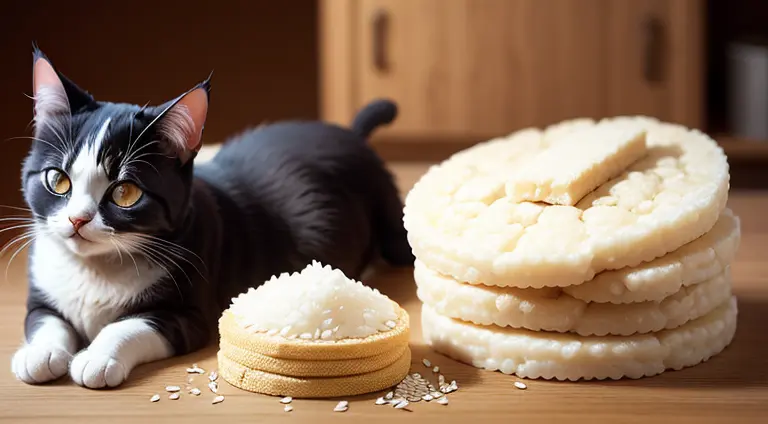As pet owners, we all want to ensure our furry friends are happy and healthy. Part of this responsibility involves making informed decisions about what our cats eat. One question that may have crossed your mind is, “Can cats eat rice cakes?” In this article, we’ll delve into this query to help you understand the potential benefits and risks associated with offering rice cakes to your feline companions.
Can Cats Eat Rice Cakes?
A. Definition of Rice Cakes
Rice cakes are crispy, wafer-like snacks made from puffed rice. They come in various flavors and are popular among humans as a low-calorie, gluten-free option.
B. Nutritional Composition of Rice Cakes
Rice cakes primarily consist of rice and salt, although some varieties may contain additional flavorings and additives. They are generally low in calories and fat, making them an attractive choice for individuals seeking a light snack.
C. Factors to Consider When Feeding Rice Cakes to Cats
Before sharing rice cakes with your cat, it’s crucial to consider several factors:
1. Ingredients and Additives
Check the ingredient list for any harmful additives or seasonings. Cats have sensitive digestive systems, and certain additives may upset their stomachs.
You can also read about: Can Cats Eat Grits
2. Portion Size
Moderation is key. Cats have specific dietary requirements, and rice cakes should only be an occasional treat rather than a regular part of their diet.
3. Potential Benefits
Rice cakes can provide some fiber and hydration due to their moisture content, but their nutritional value for cats is limited.
4. Potential Risks
There are several risks associated with feeding rice cakes to cats, including allergies, high sodium content, a lack of essential nutrients, the potential for obesity, and the risk of choking.
D. Expert Opinions and Veterinary Recommendations
Always consult with your veterinarian before introducing new foods into your cat’s diet. They can provide guidance based on your cat’s individual health and dietary needs.
Benefits of Rice Cakes for Cats
A. Potential Dietary Advantages
While rice cakes aren’t a superfood for cats, their low-calorie and low-fat nature can be useful in certain situations.
B. Fiber Content and Digestion
The fiber content in rice cakes may assist with digestion and help prevent constipation in some cats.
C. Low-Fat Option for Overweight Cats
For overweight cats, rice cakes may serve as a low-calorie alternative to traditional cat treats, but this should be done under veterinary supervision.
D. Hydration and Rice Cake Moisture
The moisture content in rice cakes can contribute to your cat’s daily water intake, potentially aiding in maintaining proper hydration levels.
Risks and Concerns
A. Allergies and Sensitivities
Some cats may be allergic or sensitive to certain ingredients in rice cakes, leading to digestive upset or skin issues.
B. High Sodium Content
Rice cakes often contain salt, which can be harmful to cats in excess. High sodium intake can lead to health problems like hypertension.
C. Lack of Essential Nutrients
Rice cakes lack many essential nutrients that cats need for optimal health. Relying on them as a primary food source for your cat is not recommended.
D. Obesity and Weight Gain
Excessive consumption of rice cakes or other high-carb snacks can contribute to obesity in cats, which comes with its own set of health issues.
E. Potential Choking Hazard
Rice cakes can be a choking hazard, especially if they are not broken into small, manageable pieces.
Alternatives to Rice Cakes
A. Cat-Friendly Snacks
Consider commercially available cat treats that are specifically formulated to meet feline nutritional needs.
B. Homemade Cat Treats
You can make homemade cat treats using cat-friendly ingredients, ensuring you have control over the quality and safety of the snacks.
C. Commercial Cat Treats
There’s a wide variety of cat treats on the market, offering different flavors and formulations to cater to your cat’s preferences.

D. Healthy Human Foods for Cats
Some human foods, like small pieces of cooked chicken or fish, can be safe and enjoyable treats for your cat in moderation.
How to Safely Offer Rice Cakes to Cats
A. Precautions and Guidelines
Always exercise caution when introducing new foods. Start with a small portion and monitor your cat for any adverse reactions.
B. Preparing Rice Cakes for Cats
If you decide to offer rice cakes to your cat, break them into small, bite-sized pieces to reduce the risk of choking.
C. Monitoring Their Reaction
Observe your cat’s behavior after eating rice cakes. If you notice any signs of discomfort or digestive issues, discontinue the treat immediately.
D. Seeking Veterinary Advice
Before making rice cakes a part of your cat’s diet, consult your veterinarian to ensure it’s safe and appropriate for your specific cat’s health.
Conclusion
In summary, while rice cakes may not be inherently toxic to cats, they should be considered a rare treat rather than a staple in their diet. Cats have unique dietary requirements, and it’s crucial to prioritize their health and well-being by offering them a balanced and species-appropriate diet. Always consult with your veterinarian before introducing any new foods to your cat’s menu, and consider safer alternatives to rice cakes for feline treats.
FAQs
1. Can I safely share a plain rice cake with my cat as an occasional treat?
While plain rice cakes may not be toxic to cats, it’s essential to exercise caution. Break the rice cake into small, manageable pieces to reduce the risk of choking, and make sure it doesn’t contain harmful additives or high levels of sodium. However, it’s best to consult your veterinarian before introducing any new food into your cat’s diet to ensure it’s safe for your specific cat.
2. Are rice cakes a suitable option for overweight cats looking for a low-calorie treat?
Rice cakes, being low in calories and fat, may seem like a good choice for overweight cats. However, any dietary changes, including treats, should be made under veterinary supervision. Your vet can recommend appropriate weight management strategies and suitable treats that won’t compromise your cat’s health.
3. What are the potential risks of feeding rice cakes to my cat?
Feeding rice cakes to your cat can come with risks, including allergies or sensitivities, high sodium content, a lack of essential nutrients, the potential for obesity, and choking hazards. It’s crucial to be aware of these risks and to consult with your veterinarian before offering rice cakes to your cat.
4. Can rice cakes serve as a source of hydration for my cat due to their moisture content?
While rice cakes do contain some moisture, they shouldn’t be relied upon as a significant source of hydration for your cat. Cats primarily obtain their necessary water from their regular drinking habits and wet cat food. It’s important to ensure your cat has access to fresh water at all times to maintain proper hydration.
5. What are some safer alternatives to rice cakes as treats for my cat?
There are several safer alternatives to rice cakes for treating your cat, including commercially available cat treats specifically formulated to meet feline nutritional needs, homemade cat treats made with cat-friendly ingredients, and small portions of healthy human foods like cooked chicken or fish. These options are generally more suitable for your cat’s overall health and well-being.

